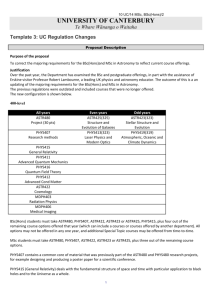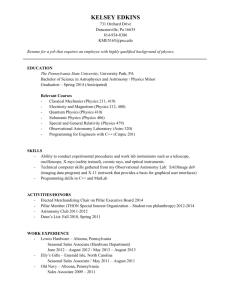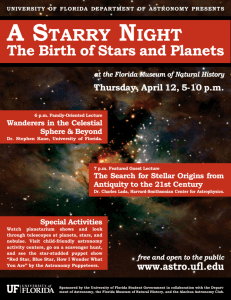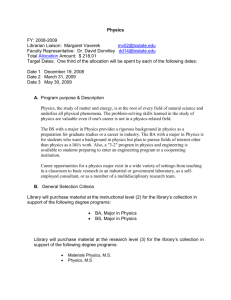Top Physics and Astronomy in Amsterdam – Strategic objectives v.0
advertisement
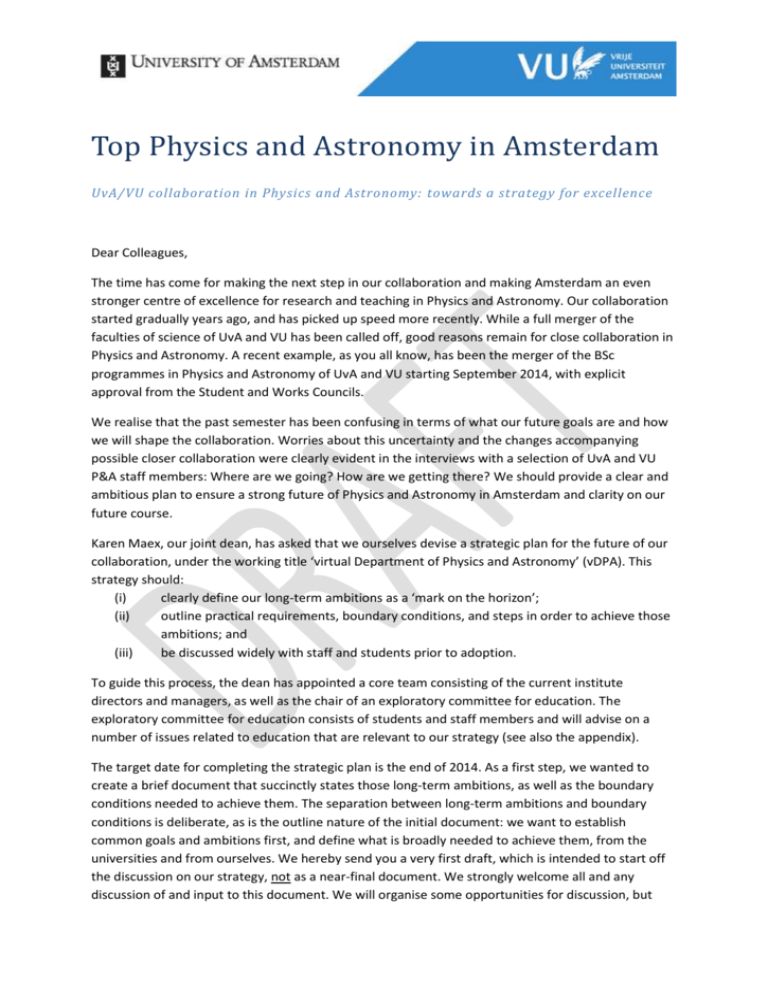
Top Physics and Astronomy in Amsterdam UvA/VU collaboration in Physics and Astronomy: towards a strategy for excellence Dear Colleagues, The time has come for making the next step in our collaboration and making Amsterdam an even stronger centre of excellence for research and teaching in Physics and Astronomy. Our collaboration started gradually years ago, and has picked up speed more recently. While a full merger of the faculties of science of UvA and VU has been called off, good reasons remain for close collaboration in Physics and Astronomy. A recent example, as you all know, has been the merger of the BSc programmes in Physics and Astronomy of UvA and VU starting September 2014, with explicit approval from the Student and Works Councils. We realise that the past semester has been confusing in terms of what our future goals are and how we will shape the collaboration. Worries about this uncertainty and the changes accompanying possible closer collaboration were clearly evident in the interviews with a selection of UvA and VU P&A staff members: Where are we going? How are we getting there? We should provide a clear and ambitious plan to ensure a strong future of Physics and Astronomy in Amsterdam and clarity on our future course. Karen Maex, our joint dean, has asked that we ourselves devise a strategic plan for the future of our collaboration, under the working title ‘virtual Department of Physics and Astronomy’ (vDPA). This strategy should: (i) clearly define our long-term ambitions as a ‘mark on the horizon’; (ii) outline practical requirements, boundary conditions, and steps in order to achieve those ambitions; and (iii) be discussed widely with staff and students prior to adoption. To guide this process, the dean has appointed a core team consisting of the current institute directors and managers, as well as the chair of an exploratory committee for education. The exploratory committee for education consists of students and staff members and will advise on a number of issues related to education that are relevant to our strategy (see also the appendix). The target date for completing the strategic plan is the end of 2014. As a first step, we wanted to create a brief document that succinctly states those long-term ambitions, as well as the boundary conditions needed to achieve them. The separation between long-term ambitions and boundary conditions is deliberate, as is the outline nature of the initial document: we want to establish common goals and ambitions first, and define what is broadly needed to achieve them, from the universities and from ourselves. We hereby send you a very first draft, which is intended to start off the discussion on our strategy, not as a near-final document. We strongly welcome all and any discussion of and input to this document. We will organise some opportunities for discussion, but there is no need to wait for those. It is an explicit goal of our planning process that it be fed as much as possible by comments from staff members and students. After discussion, we will present the resulting outline strategy to the dean, and discuss the conditions and requirements with her; this may of course lead to some iteration, after which a final version is established. Based on that, we write a more detailed strategy. We expect the collaboration to intensify gradually, and some goals such as the co-location of research in Physics and Astronomy at Science Park to take a number of years, so naturally our plan will not provide a complete blue-print of the eventual situation we wish to achieve. Rather, it should define what we aim for in that eventual situation, and be very concrete on the steps we shall take towards it in the first few years. Cordially yours, The vDPA Core team: Daniel Bonn, Annemarie van Groenestijn, Niels Laurens, Joost van Mameren, Wim Vassen, Ralph Wijers, Gijs Wuite. Top Physics and Astronomy in Amsterdam – Strategic objectives v.0 As a first step towards a strategic outline, the core team has defined five strategic objectives for Physics and Astronomy in Amsterdam, to define what we are aiming for in the longer term. The five strategic objectives 1. A leading international position of (inter)disciplinary Physics and Astronomy in Amsterdam 2. Top level education offering the whole range of (inter)disciplinary Physics and Astronomy, connected to top level research 3. A dynamic, lively, inspiring meeting place 4. Top level research facilities 5. Clarity and quality in governance The overarching goal behind these five strategic objectives is to take research and teaching of Physics and Astronomy in Amsterdam to a higher and more ambitious level, with a leadership position in Europe. For each objective, one can define conditions that need to be fulfilled or goals that need to be achieved, listed in the next section. Some of these may seem obvious, yet it is still important to jointly agree on those, too. Others imply a clear choice for the future, accompanied by marked changes to the present institutions that jointly form the vDPA. A selection in the latter category: No distinction between as well as equal opportunities for VU and UvA employees Transparent system for career planning (including tenure track) Excellent facilities in a coherent experimental physics facility at Science Park Successful move of the LaserLab facilities to the Science Park with maximum compliance to space, vibration and climate requirements Fostering strong connections with Neuroscience campus, VUmc and O|2 to optimise the embedding of physics of life research Ambitious teaching, with a wider range of options in classes and projects for all students All BSc and MSc education will in principle be in English Teaching performance becomes more important in scientific careers Reporting, evaluation, etc. as a true single entity Pre-conditions to the strategic objectives 1. A leading international position of disciplinary and interdisciplinary Physics and Astronomy in Amsterdam: a. Excellence in a broad range of subfields of physics and astronomy, as well as in interdisciplinary connections with other fields b. Represent Physics and Astronomy in Amsterdam as a single entity to the outside world (“one website”) c. Staff talent magnet: d. e. f. g. h. i. i. Use start-up packages to be more competitive on the job market ii. Transparent system for career planning (including tenure track) iii. Make everybody feel at home iv. Excellent office facilities v. Good supporting staff vi. Official language: English vii. Attractive guest accommodation viii. Visiting programme Student talent magnet: i. High-quality mentoring and tutoring ii. Creation of an international visibility/image iii. MSc scholarships iv. Active participation of students v. Smooth and easy processes Excellent research facilities; Fostering strong connections with Neuroscience campus, VUmc and O|2 to optimise the embedding of physics of life research Active, strong bonds with other research institutes in Amsterdam, in particular with ARCNL, SRON, AMOLF, and Nikhef Increased attractiveness of Science Park Robust budget i. Good internal and external funding/earning power ii. Opportunities and resources for collaboration 2. Top level education offering the whole range of (inter)disciplinary subjects and top research: a. Ambitious teaching, with a wider range of options in classes and projects for all students b. The virtual department is home and host for BSc and MSc students from Physics and Astronomy, Medical Natural Science and Science Business and Innovation1 c. All BSc and MSc education will in principle be in English d. A lively and happy student population: i. Frequent direct contact between research staff and students, in relatively small settings ii. Attract international students: reputation, branding, housing iii. Flourishing students’ association with close links to research organisation iv. Adequate staff members/facilities to support students in projects, internships, labs e. Teaching performance becomes more important in scientific careers: i. Educational quality: explicit recognition of educational skills in annual performance reviews 1 To ensure strong connections with VUmc and Human Life Science research required by the MNS and SBI programmes, these should be shared with other departments. ii. Recognition of education: 1. Award ‘best teacher of the year’, ‘principal educators’ 2. Bonus or other reward for top teaching / exceptional teaching load iii. Fair and clear teaching expectations for staff at all levels, in particular for TA work by PhD students iv. High-quality support for students and teachers from tutors, coordinators, advisors, administrative staff 3. A dynamic, lively, inspiring meeting place: a. Campus life: i. Creation of a campus feeling ii. A meeting place for many international visitors iii. An inspiring place with good coffee :-) iv. High-level department-wide colloquium with exclusively top level speakers v. Students, researchers and staff intermingle, no entrance gates b. Culture: i. An open culture and management style ii. A transparent, flat organisation that feels safe iii. Respected staff, regardless of job description or background iv. Personal professional autonomy c. Connections: i. Enhanced ties with local, national and international organisations and institutes ii. Close relation between education and research iii. Good connections and collaboration with Zuidas Campus and the other faculties of UvA and VU iv. Active role in relevant societal debates and outreach, open attitude to society in general, projecting the image of a ‘happening place’ 4. Top level research facilities: a. Excellent facilities in a coherent experimental physics facility at Science Park b. Successful move of the LaserLab facilities to the Science Park with maximum compliance to space, vibration and climate requirements c. Successful move of SRON and VU Earth Science to the Science Park in direct vicinity (‘gangway distance’) of the vDPA facilities d. Excellent technical support staff and facilities e. Attraction of internationally prominent research or shared user facility/ies to Science Park that generate a large international visitors throughput 5. Clarity and quality in governance: a. Governance is through broad goals and result-oriented, respecting appropriate autonomy of sub-units and individuals (“micro-management is mismanagement”) b. Responsibility and accountability on matters lies with those who have the authority c. External governance: i. Well-defined, adequate, fair and identical funding arrangements with FEW/VU and FNWI/UvA ii. Well-defined representation of Physics and Astronomy in FEW and FNWI iii. Autonomy in arranging internal governance and support to suit the needs of Physics and Astronomy iv. Minimise the administrative load on scientific staff v. Well-defined support arrangements for Physics and Astronomy vi. High-level support from VU and UvA in external representation and attracting large projects vii. Reporting, evaluation, etc. as a true single entity, avoidance of ‘double jeopardy’ viii. Balanced and fair distribution of management and education tasks over all staff d. Internal governance: i. No distinction between as well as equal opportunities for VU and UvA employees ii. vDPA is subdivided into institutes/divisions, with a significant level of autonomy, and preserved ‘brand names’ iii. Clear structure of departmental governance iv. Clear division of responsibilities between department and institutes/divisions v. Clear financial management of department and institutes/divisions Appendix - Membership and tasks of the teams Core team Members The core team consists of the following people: Daniel Bonn (contact person): director UvA Institute of Physics Annemarie van Groenestijn: institute coordinator UvA Anton Pannekoek Institute Niels Laurens: department manager VU Physics Joost van Mameren: institute manager UvA Institute of Physics Wim Vassen: chair exploratory committee Ralph Wijers: director UvA Anton Pannekoek Institute Gijs Wuite: department head VU Physics Task Direct and oversee the development of a strategy for the virtual Department of Physics and Astronomy (vDPA). Exploratory committee for education Members The exploratory committee for education, which advises the core team on strategic matters regarding education, consists of: Wim Vassen (chair): programme director MSc Physics VU Marcel Vreeswijk: programme director joint BSc P&A Sera Markoff: programme director MSc Astronomy & Astrophysics Ben van Linden van den Heuvell: programme director MSc Physics UvA John Kennis: programme director Medical Natural Sciences Erwin Peterman: teacher VU Kareljan Schoutens: teacher UvA Tim Barenbrug: MSc student (UvA); former chairman student association NSA Ruud van der Beek: MSc student (VU) Zazo Meys: BSc student (UvA); member FNWI student council Jim Visschers: BSc student (VU); former chairman student association Aik Joost van Mameren will act as secretary to the committee Task Advise on the following specific educational matters, as well as other matters that may arise: Proposal for measures to increase student satisfaction, particularly in view of the increasing student numbers in the BSc programme Physics & Astronomy Implementation of an all-English BSc programme Physics & Astronomy Pros and cons of a numerus fixus for the BSc programme Physics & Astronomy Organisation and embedding of SBI/MNW/MNS programmes within the vDPA Embedding of A&A programme as track in a joint MSc programme Physics & Astronomy, and relation to other Physics & Astronomy tracks Further shaping and organisation in the MSc programmes and their tracks: o alignment of all tracks o future of tracks system o construction of new tracks relating to SRON/Earth Sciences and/or NanoLithography o alignment with other programmes in vDPA, primarily MNW/MNS/SBI o formulation of potential admission requirements for the MSc programs o issues related to double BSc programmes Sounding board to the exploratory committee For several of the above educational subjects, the exploratory committee will need to obtain expert opinions from within the community. In order not to make the committee unworkably large, and still ensure a proper consultation/discussion on those topics, a sounding board / expert group will be in place. Individual members can be invited to committee meetings depending on the topics. Preliminary list of members to the sounding board Jan de Boer: general advisor as member of the former ‘Fundamentals of Science’ education duo (with Romanu Orru) Carsten Dominik, Rudi Wijnands and 1 or 2 A&A MSc students (advising on the embedding of the A&A programme) Bart Bossink and Jan Dekker (advising on matters related to the SBI programme) Coordinators of the MSc tracks (advising on matters related to the various tracks): o GRAPPA/particle: Patrick Decowski and Henk-Jan Bulten o TP: Bernard Nienhuis and Piet Mulders o AMEP: Peter Schall and Maurice Janssen o PLH: Ton van Leeuwen and Stefan Witte o SfES: Bas de Bruin (HIMS) and John Kennis Gerrit Kuik (advising on matters related to the student laboratories)


